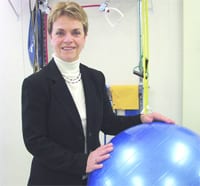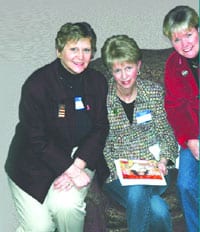Demanding Work That Is in Demand Social, Demographic Changes Create Opportunities for Physical Therapist Assistants
Linda Desmarais says that most of those enrolled in the Physical Therapist Assistant program at Springfield Technical Community College are working toward second careers.
“Some have come from banking, others from computers, some from management and administration, and still others from the fitness field … they’re from a variety of different backgrounds,” said Desmarais, professor and chair of the department, who told The Healthcare News that, before choosing this field, applicants did considerable research into this and other options.
And what that research told them is that this one of the most in-demand professions in health care, she continued, noting that an aging population; advancing medical science, which has made hip, knee, and other joint replacement commonplace; and a greater emphasis on fitness and sports (and resulting injuries) has created this demand.
And they will likely keep on creating it, she said, adding that these societal and demographic changes have greatly increased the workload and professional opportunities for physical therapists — and their assistants.
These are two different career tracks, Desmarais explained, noting that most PTs joining the field must possess a doctorate (seven years of secondary school), while PTAs, as they’re called, must have an associate’s degree and pass a licensing exam. With those credentials, these individuals work with and for the physical therapist to administer a prescribed regimen of care.
“The physical therapist assistant has a body of skills very similar to the physical therapist,” she explained, adding that if one is injured or recovering from surgery, the PT will draw up a plan of care that identifies needs and goals. “That report is then handed off to the physical therapist assistant to implement.”
The work of the PTA brings rewards on a number of levels, said Desmarais, including the financial (starting salaries approach $40,000 in this market) and the satisfaction that comes with helping someone recover from stroke, head injury, serious sports injury, or one of those aforementioned joint-replacement procedures.
“For many of the participants in the program, what they’re looking for at that stage in their life is a quality job where they can help people,” she said. “And that’s what this field provides.”
Course of Action
Desmarais told The Healthcare News that it was a series of cataclysmic events — two world wars and a polio epidemic that didn’t really end until the 1950s — that gave rise to the position of physical therapist.
Actually, until just after World War II, such individuals were known as “reconstruction aides,” she continued, noting that this title accurately reflected the work done to assist those who had suffered severe injuries during the wars. The title changed, and so did the scope of the work, she went on, adding that a host of factors, from the growing numbers of Americans participating in sports (and often injuring themselves in the process) to the aging Baby Boomer generation, to advancing science and technology, has created much greater demand for PTs and PTAs.
Indeed, there are now job opportunities in a host of settings, she explained, including hospitals, outpatient clinics, rehabilitation clinics, nursing homes and other kinds of long-term care facilities, and even schools, following a mainstreaming of individuals with physical and behavioral disabilities.
This explains why there are usually 80 or more applicants for the 20 slots in the PTA program at STCC, the only one in the Pioneer Valley, said Desmarais, adding that more than two-thirds of those in each new class will graduate, and most all of them will have jobs waiting for them.
This competition to get into the program, as well as the employment opportunities awaiting those who graduate, makes participants in this program, in a word, motivated, she continued, adding that this makes her job easier and more fun.
“This is the ideal program to teach in,” she explained. People have to compete to get in, and they want to stay in.”
If they do stay in, they will be exposed to a wide array of subject matter, Desmarais continued, who added simply, “we pack a lot into those two years.”
There are technical and clinical matters, obviously, she noted, as evidenced by courses ranging from Anatomy to ‘Orthopedic Treatment Procedure’; from Kinesiology to ‘Lifespan Human Growth and Development.’ There is also a seven-week supervised clinical experience that caps off the program.
But there are also many human elements to this profession, she continued, things that can’t be learned from a textbook, but rather from watching and certainly by doing. Elaborating, she said that recovery from injury, illness, and surgery is a difficult time for patients. PTs set a course for such people, but it is very often the responsibility of the PTA to see that the patient stays on course. And this requires a blend of compassion, but also what might be described as some tough love.
“The physical therapist assistant has to be the cheerleader,” she explained, “because in most cases, the patient is miserable — for them life isn’t fun, they’re in pain, and they don’t really want to be there (in rehab). You have to be able to shake them up, motivate them, and get them to own their plan.
“This is not a passive field anymore,” she continued. “People don’t come, get a hot patch thrown on them, and get a massage; this is something they have to work on, and the physical therapist assistant often has to be a motivator.”
To succeed with such work, a PTA must be a good ‘people person,’ she explained, but more than that, he or she must be an educator.
“You have to be able to inform, or teach, the patient about what it is that’s wrong with them,” said Desmarais, “and why they have restrictions placed on them, and why they have to work to reach their goal.”
Many of the students gain some practice in all of the above at an on-site facility called the Campus Rehab Clinic at STCC. Working under the supervision of faculty, PTA students provide care to those who have no insurance or have seen their benefits for physical or occupational therapy run out, but still need care, said Desmairais, adding that the clinic often provides an effective bridge between the classroom and the real world, and meets a critical need within the community in the process.
Textbook Examples
Desmarais said that, for the foreseeable future, the work of the PTA will remain in such high demand that those doing research on health careers for years to come will consider this a very attractive option.
The money is good and the opportunities plentiful, but there is more to it than that. The work is rewarding, she continued, and on a number of levels.
This should get people motivated to join a profession where part of their unofficial job description is to motivate others.



Comments are closed.